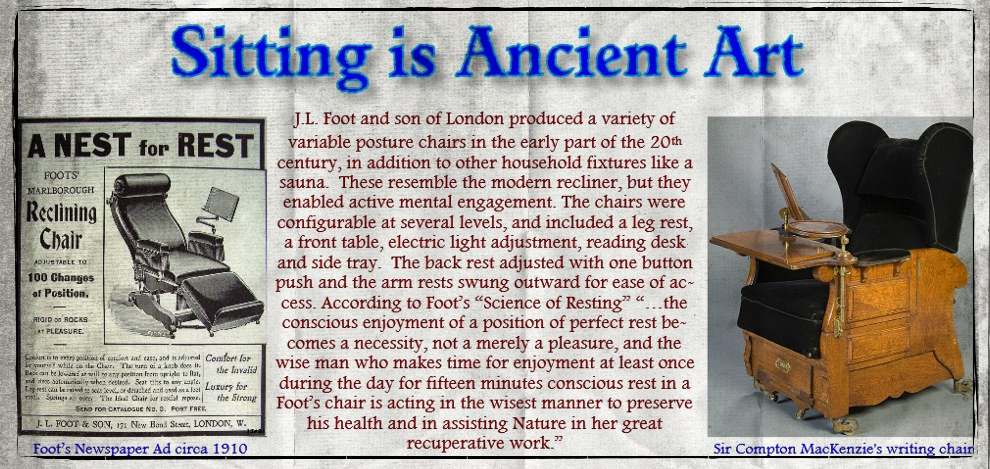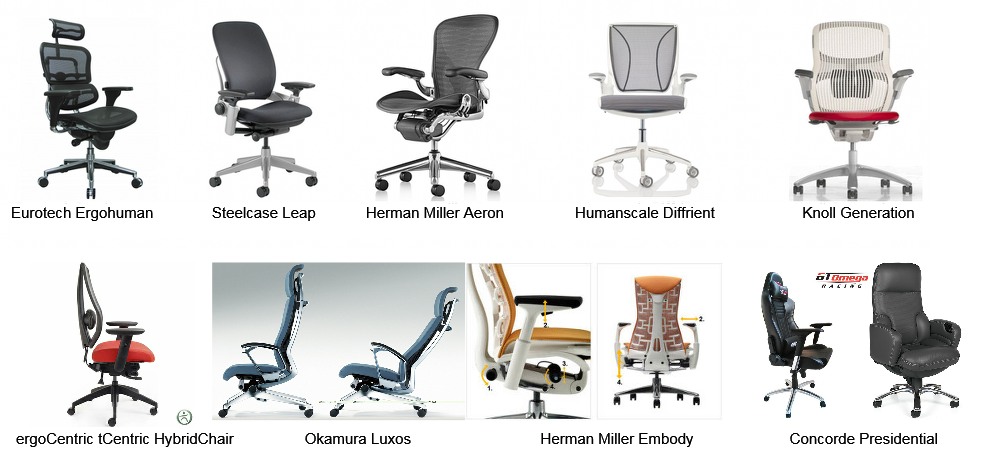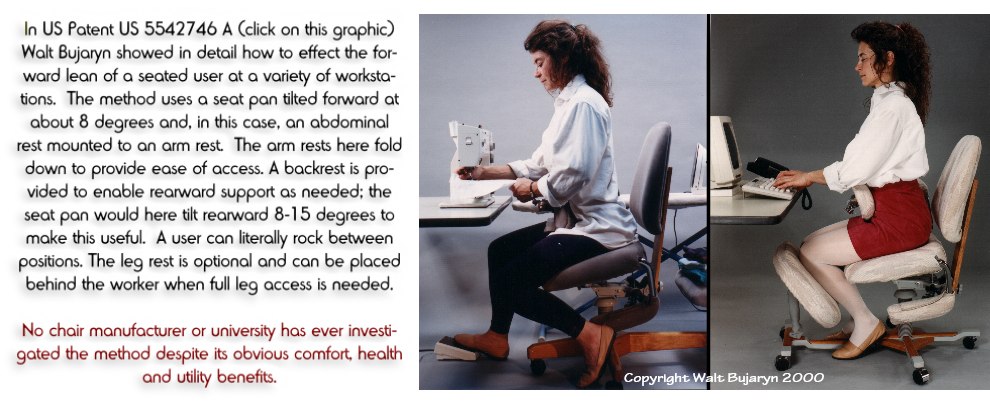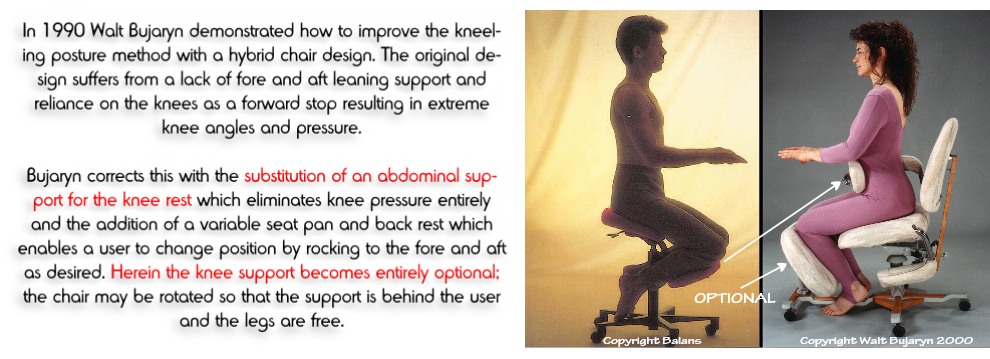HOME • FUTURE OF SEATING • THE 90 DEGREE PARADIGM • SITTING AND ITS DISCONTENTS
CATEGORIES OF CHAIRS • SIT STAND TREADMILL • CONTACTS
COMMENT IN A BLOG
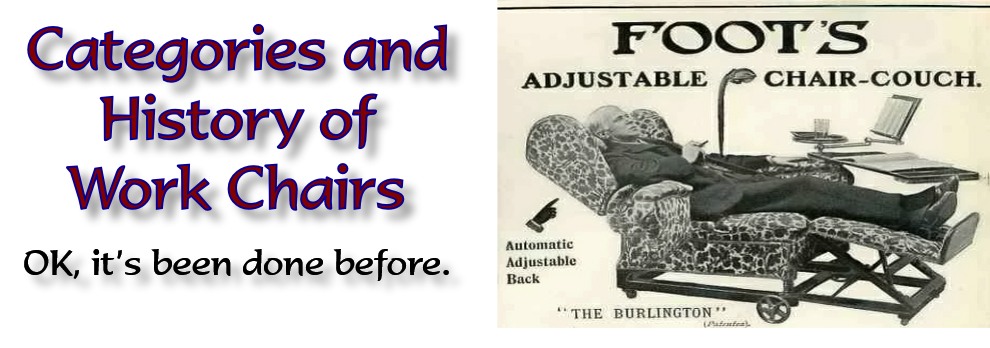 I. Conventional Chairs • IA. Conventional Recliners • II. Forward Lean • III. Reversible Chairs • IV. Kneeling Posture • V. Stools and Balls • VI. Personal Workstations • VII. Hybrids
I. Conventional Chairs • IA. Conventional Recliners • II. Forward Lean • III. Reversible Chairs • IV. Kneeling Posture • V. Stools and Balls • VI. Personal Workstations • VII. Hybrids
Conventional chairs utilize the 90 degree paradigm instruction set. These are the chairs you are mostly familiar with. They are everywhere. They have a base and elevation assembly, a seat pan, a back rest and, optionally, arm rests. They are probably the only chair you have ever seen in an office. They come in an endless variety of sizes and configurations, but they’re all of the same class.
Comments
The U.S. office furniture industry is valued at some $23 billion annually. With some 3800 players in the field one could call it “fragmented”. About half of that $23B amount is commanded by five majors — Steelcase, Herman Miller, Haworth, Knoll and HNI. None of these companies enjoy any significant competitive advantage over the other, all run about the same gross margins, and all produce essentially similar products. They just pursue different ways of accessing the same market.
The seating design overwhelmingly produced by the industry is the conventional chair. It has a base, elevation support, a seat pan and a back rest. Optionally, it may, and normally does, have arm rests. A great number of adjustments have been built into the device, but it remains essentially designed around the 90 degree paradigm.
Pros
Over the years, the conventional chair has significantly improved, although most of those improvements have been modest. Still, movement away from the stifling 90 degree paradigm, as seen in the Herman Miller Envelop workstation, is an encouraging development. Quality is, overall, quite good, and users who have found a design they like seem to be satisfied. Others remain frustrated.
Cons
Over the years the modern workstation has become the main source of what can be called “workplace sitting disease” and since the conventional chair with its 90 degree paradigm is the dominant method of sitting at a workstation the finger of blame is increasingly being pointed in that direction. Workstations were not designed with the biomechanical needs of a human being in mind; they came first, and the human had to be fit into the equation. The results, as measured by medical and lost productivity costs, have been a disaster. This is covered in detail in other pages on this site.
The other chief problem is lack of differentiation and real innovation. This isn’t like the auto industry. Revolutions are hard to come by. The Herman Miller Aeron, arguably the last real “game changer” the industry produced, appeared in 1994. All five majors are dealing with the same paradigm that hasn’t changed much over the years and changes that they are mandated to call “innovative” really amount to very little as far as the chair user is concerned. Herman Miller’s “Pixillated Support” in its Embody back rest is a case in point, a touted innovation that adds significant expense and yields very little in benefit to a seated user. But, it gives them something to point to in the literature, and that makes some people happy.
Because they can produce very little in the way of functional innovation chair manufacturers are forced to turn to designers to differentiate product. Designers are, by definition, far more concerned with the “look” of a chair than they are with its ease of use and comfort. Sexiness and the illusion of technical prowess are paramount. Hence the emphasis on thin, hard seat pans (Okamura Luxos above) which supposedly look good on the cover of a catalog but which are guaranteed to disappoint the chair buyer who is seeking long term seating comfort. One would doubt that anywhere on the planet can engineers and designers be found who are being paid so much to produce so little as they are in the chair industry.
A particular sore point with many buyers is that despite the perceived high cost of a modern office chair — often up to $1500 — the value as measured in comfort, usability and overall satisfaction is often not apparent. Still, there are those who remain happy with the devices.
 Some manufacturers have been adding on leg rests and making their chairs recline further than normal to enhance reclining and stretching capabilities.
Some manufacturers have been adding on leg rests and making their chairs recline further than normal to enhance reclining and stretching capabilities.
 Comments
Comments
When providing leg and foot rest for a seating device a designer has two choices: he or she can attach it directly to the chair, or it can be built separately, as an ottoman. The manufacturers of IA above remain dedicated to the conventional chair design but they have increased the range of motion of the backrest and have added a leg support that is attached to the seat pan.
While many will see this as an improvement, bolting the leg rest to the seat pan is a poor design solution. When left extended the rest inhibits the rotational abilities of the assembly and forms an eternal collision obstruction for the legs and feet. For a user to get into or out of the chair they must swing their legs over the rest and onto the floor; if the chair is positioned under a desk this can be a problem. Alternatively, one can lower the extended rest, but a repetition of this movement thousands of times a year may be more hassle than many users want.
Additionally, stability issues with the assembly when in an extended reclining position are open to question.
Forward lean support chairs. There is a class of chair designed to do just that. And, if we support the rearward lean of a seated user why not to the fore?
 Comments
Comments
The forward lean as a potential sitting position was thoroughly covered by Walt Bujaryn in US Patent US 5542746 A; click on the drawings. Hector Serber, another chair designer, has also addressed the issue extensively. It is an extremely useful and comfortable way to sit. Its chief benefit lies in supporting the forward lean of a user when he or she works in that fashion. The support member is less desirable when fashioned as a full chest rest, particularly for women, but when the support is in the form of an abdominal rest the effect is superb. The mount for the rest must come from the side of the chair, not up between the legs. There is no need for lower lumbar support with forward sitting use because the small of the back is naturally forced inward, as is biomechanically desirable.
The design has vast industrial potential applications, but to date has not found its way to significant market share. This is mainly because no one has investigated it. This is stunning. Despite hundreds of white papers and studies and reams of advice on how to sit not one university or chair manufacturer has investigated or even mentioned the blatantly obvious alternative to the conventional sitting position of supporting the forward lean.
As shown above, the method is considerably improved with the addition of a back rest and a seat pan that enables rocking between fore and aft.
Reversible chairs. Any chair with a simple back rest can be reversed, sort of, but there have been a variety of dedicated attempts.
 Comments
Comments
Reversible chairs are exactly what you would expect, a chair that has a back rest that can be turned around to accommodate the forward lean as well. The first reversible I found was Benson 2,364,050 dated 1945, but I’m sure there were others. Wilson 454,100 inferred in 1891. Nonetheless, the design has its limitations in practice. What works well to support the rearward lean does not work so well to the fore, mainly due to the necessary size of the back rest. Leaning to the fore really wants an abdominal rest, and this is too small to adequately support the rearward lean. Further, when the post of forward support comes up between the legs entry and exit to the chair can be awkward, and virtually impossible for a woman wearing a dress.
The only reversible that appears to be in production would be Peter Opvisk’s Saddle Chair, pictured above. HAG, the builder, pushes the chair for long term sitting, but it is difficult to see anything other than light task duty with this one. And note that the female models must be dressed in pants.
Kneeling posture chairs which appeared as a revolution in sitting in the 1970-80’s are still around. For the most part they accommodate a single position, that of kneeling, although there are variations.
 Comments
Comments
This is one of those postures that works well for photography. It demands a thin, svelte 20- something body as its model because none other works. And if you think sitting in a conventional fashion is painful, you should try kneeling for extended periods of time.
In the kneeling posture the seat pan is tilted forward, generally in the 8-10 degree range. Less tilt and you just have a stool; more is too much. This range enables a good, natural curve in the lower back and results in all those perfectly positioned spines you see. To keep the body from sliding forward and off of the pan, which must have grippy material, a knee rest is provided as a stop, and herein begin the troubles. Keeping pressure on the knees for extended periods can result in unbearable pain at those joints, and once it begins a return to the position is nearly impossible. Further, and note this in the pictures above, the angles at the knees often well exceed even the 90 degrees of the conventional device. This is additionally crushing to the joints and inhibits circulation. Tight pants are out of the question.
Sitting ramrod upright might look great in the pictures, but a user often tires in this position and begins to slump. The device is improved with the addition of a backrest for rearward relief and possibly a rocker, but this remains a domain of the young, healthy, dedicated… and few.
A variety of stools and rubber balls are in use to varying degrees. This approach can best be described as “simplicity”.

Comments
A stool is a stool and a ball is a ball. Not much else to say. You get a single point of support and other than height there’s nothing to adjust. The pan angle is variable but not fixed with the ball and the Swopper, and there is a bounce or springiness that seems to appeal to some people. Attempts to add a back rest just result in an unconvincing and not very comfortable chair. The simpler stools have a very small footprint and are going to be very tough for extended sitting. The Swopper does reorient continuously, has a loyal following and has maintained good sales figures through its existence.
As for the ball, sitting on air is really the best seat pan one can ask for. There is an instant and ongoing conforming to the shape of the buttocks and thighs, and this is as good as or better than a top quality foam and gel combination. This alone subtracts from stress levels and is probably why some sitters stay with it. Putting an air seat pan into a chair (not like the Ball Chair shown) would be an act of genius.

Dedicated personal workstations. From school desks on up, these are seating devices designed to get your work done without a separate desk, at least for a monitor and keyboard.
 Comments
Comments
This is where things start to get interesting. More ingenuity has been expended in the area of building personal workstations than any other area of contemporary seating design. Clicking on the image above will link you to a general search that will give you some idea as to how extensive this field has become. Some of this is driven by gaming for which it is a natural application. We haven’t seen banks of these appearing anywhere yet, may be wrong on that, but it appears to be a lone wolf type of installation, so if you have a place to put one and money isn’t an issue, it might be worth a look.
If you fully understand what you’re getting into (caveat) this could be a decent way to get significant amounts of work done, or spend endless hours gaming. The units are designed to be an ergonomic dream, with perfectly positioned monitors and keyboards and builds that should enable long term seating. But looks can be deceiving.
Therein lies the rub. The apparatus involved tend to be rather large and often, but not always, semi-immobile. And you don’t join one of these with a preexisting desk or workstation, because it IS the workstation. That can be an issue for those who still need a traditional desk to perform office chores. So it may become an adjunct to, rather than a replacement for, a traditional desk, thereby requiring more room. Supposing that you have the space, some will love the “look” and others will hate it.
These really are a one trick pony design. There is nothing task, or executive, or social about them. You get into one to work a computer, period, although reading may be an option. Entry and exit can be a little more cumbersome than a regular chair. Which brings up the next and most important point: It is possible to design a workstation in a more traditional fashion using a desk and a top flight chair (OK, we’re talking hybrid here) that accomplishes all the same goals without the extra stand alone hardware. That realization is what usually stops people from taking the leap.
Finally, you really need to try one of these out before buying, and that is always an issue with online purchases. Don’t assume that because it looks high tech or sexy or that certain claims are being made that it is going to be comfortable. The seating is probably going to be of very limited movement and adjustment. It may, in fact, totally suck. Some, like the Demni Frog above, look to have the back curved in exactly the wrong way with no changes available. So, think three times and be absolutely sure you have this one right before committing. It’s a bitch to send one of these back.
Hybrids are the most difficult class of chair to build because they must encompass two or more of the foregoing classes. The Renegade Space™ design is the most successful hybrid ever put forth, and of actual designs there are really only two, one by Bujaryn and one by Serber (see inks below). One could include any variable posture design, such as a recliner, within this class, but here we are only concerned with work chairs, devices designed to be used at a workstation.
A critic might state that certain conventional chairs attain forward lean, upright and partial recline, but their basic design limits their effectiveness in showing all three positions.
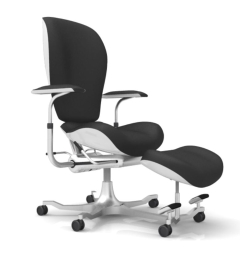 Comments
Comments
The images above show the range of configurations available in the hybrid chair design by Walt Bujayn. Note that all planes of body support in this design operate independently of each other and that the arm rest assembly is self-leveling. The seat pan tilts over a range of 33 degrees, enabling access to the full range of potential seating at a workstation. The chair acts as a kneeling posture device, a task and executive chair, a partial recliner, a full recliner and a horizontal stretching device. When configured with an optional abdominal rest it can function as a chair that supports the forward lean, thus accomplishing the goals of the reversible chairs. When fitted with an optional keyboard assembly it can function as a stand alone personal workstation. It is the versatility of the design that sets it apart from other classes of seating devices.

HYBRID PATENTS: BUJARYN 5,542,746 BUJARYN 5,984,408 SERBER 4,832,407
TOP • HOME • FUTURE OF SEATING • THE 90 DEGREE PARADIGM • SITTING AND ITS DISCONTENTS • CATEGORIES OF CHAIRS • SIT STAND TREADMILL • CONTACTS • COMMENT IN A BLOG

